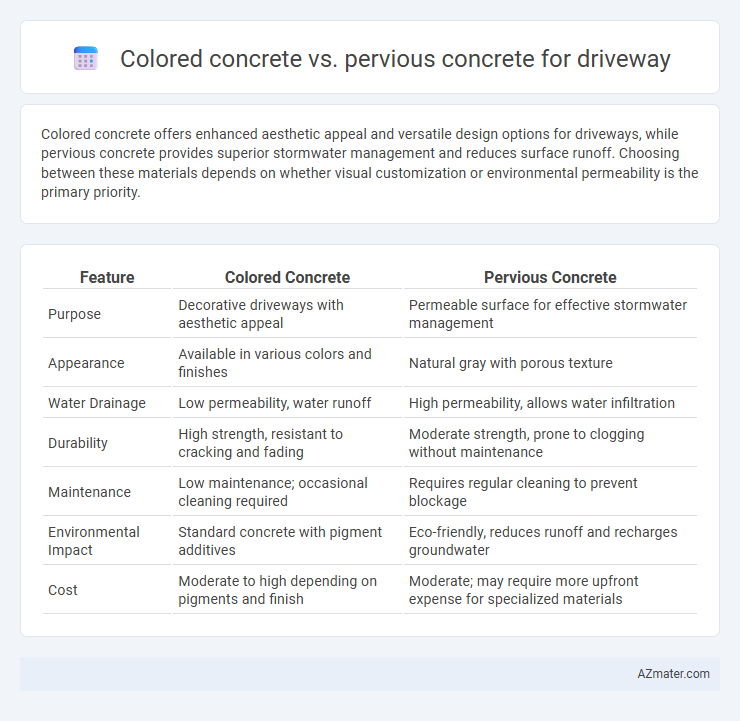Colored concrete offers enhanced aesthetic appeal and versatile design options for driveways, while pervious concrete provides superior stormwater management and reduces surface runoff. Choosing between these materials depends on whether visual customization or environmental permeability is the primary priority.
Table of Comparison
| Feature | Colored Concrete | Pervious Concrete |
|---|---|---|
| Purpose | Decorative driveways with aesthetic appeal | Permeable surface for effective stormwater management |
| Appearance | Available in various colors and finishes | Natural gray with porous texture |
| Water Drainage | Low permeability, water runoff | High permeability, allows water infiltration |
| Durability | High strength, resistant to cracking and fading | Moderate strength, prone to clogging without maintenance |
| Maintenance | Low maintenance; occasional cleaning required | Requires regular cleaning to prevent blockage |
| Environmental Impact | Standard concrete with pigment additives | Eco-friendly, reduces runoff and recharges groundwater |
| Cost | Moderate to high depending on pigments and finish | Moderate; may require more upfront expense for specialized materials |
Introduction to Driveway Concrete Options
Colored concrete offers enhanced aesthetic appeal with customizable hues and patterns, making it ideal for decorative driveways that complement home exteriors. Pervious concrete provides superior water drainage by allowing rainwater to pass through, reducing runoff and promoting groundwater recharge, perfect for environmentally conscious homeowners. Both options deliver durability and low maintenance, but the choice depends on whether visual design or sustainable water management is the priority.
What is Colored Concrete?
Colored concrete is a type of decorative concrete that incorporates integral pigments into the mix to achieve a consistent, vibrant hue throughout the entire slab, making it ideal for enhancing driveway aesthetics. This material offers durability and low maintenance while providing a wide range of color options to complement various architectural styles. In contrast, pervious concrete emphasizes permeability for stormwater management but typically lacks the rich, uniform coloration found in colored concrete.
Understanding Pervious Concrete
Pervious concrete is designed to allow water to pass through its porous structure, reducing runoff and promoting groundwater recharge, which is ideal for environmentally conscious driveway solutions. Unlike colored concrete, which primarily focuses on aesthetic appeal through pigmentation and surface finishes, pervious concrete emphasizes sustainable water management and stormwater control. Its open-graded mix with reduced fines creates interconnected voids, making it highly effective for permeability while maintaining adequate strength for residential driveway applications.
Aesthetic Appeal: Colored vs Pervious Concrete
Colored concrete offers vibrant, customizable hues that enhance driveway aesthetics by providing a polished, uniform appearance suitable for modern or classic styles. Pervious concrete emphasizes functionality with its porous texture, allowing water drainage but delivering a more natural, less consistent surface that may lack the vivid color options of colored concrete. Choosing between them depends on prioritizing striking visual impact through color or ecological benefits with a more subdued, textured look.
Durability and Longevity Comparison
Colored concrete offers superior durability with high resistance to wear, fading, and environmental stress, making it ideal for long-lasting driveway surfaces. Pervious concrete provides excellent drainage and reduces runoff but typically has lower compressive strength and may require more maintenance to prevent clogging and deterioration over time. Evaluating the balance between colored concrete's robust longevity and pervious concrete's environmental benefits is crucial for selecting the best driveway material.
Environmental Impact: Which is Greener?
Colored concrete uses pigments that do not significantly impact the environment but may involve energy-intensive production processes, whereas pervious concrete enhances groundwater recharge by allowing water to pass through, reducing runoff and promoting eco-friendly stormwater management. Pervious concrete's porous structure supports natural filtration and decreases urban heat island effects, making it a more sustainable choice for driveways in terms of environmental benefits. The permeability and reduced surface runoff associated with pervious concrete contribute to lower pollution levels in nearby water bodies, positioning it as a greener option compared to colored concrete.
Maintenance Requirements for Both Types
Colored concrete driveways require regular cleaning to prevent stains and periodic resealing every 2-3 years to maintain color vibrancy and surface protection. Pervious concrete demands routine debris removal to keep its porous structure effective, allowing water infiltration and reducing runoff, with occasional inspection to address clogging or sediment buildup. Both materials benefit from prompt repair of cracks to preserve durability, but pervious concrete typically involves more frequent surface maintenance to sustain permeability.
Cost Analysis: Initial and Long-term
Colored concrete driveways typically have a higher initial cost due to pigmentation and specialized finishing, ranging from $8 to $15 per square foot, but offer durable aesthetics with minimal maintenance. Pervious concrete, priced around $10 to $12 per square foot upfront, provides enhanced stormwater management benefits that can reduce long-term drainage expenses and minimize environmental fees. Over time, pervious concrete may require periodic vacuuming to maintain permeability, adding to maintenance costs, while colored concrete mainly incurs occasional sealing costs to preserve color vibrancy and surface integrity.
Best Use Cases and Applications
Colored concrete enhances aesthetic appeal and is ideal for residential driveways seeking customization with vibrant, long-lasting hues that resist fading and stains. Pervious concrete excels in environmental applications, providing superior stormwater management by allowing water to infiltrate and reducing runoff, making it suitable for eco-friendly commercial or municipal driveways. For homeowners prioritizing visual impact and design, colored concrete is best, whereas pervious concrete fits projects emphasizing sustainability and drainage performance.
Choosing the Right Concrete for Your Driveway
Colored concrete offers aesthetic versatility and enhanced curb appeal, making it ideal for homeowners prioritizing design and customization. Pervious concrete excels in managing stormwater runoff by allowing water to permeate, reducing puddles and minimizing environmental impact. When choosing the right concrete for your driveway, consider both visual preferences and functional needs such as drainage efficiency and local climate conditions.

Infographic: Colored concrete vs Pervious concrete for Driveway
 azmater.com
azmater.com